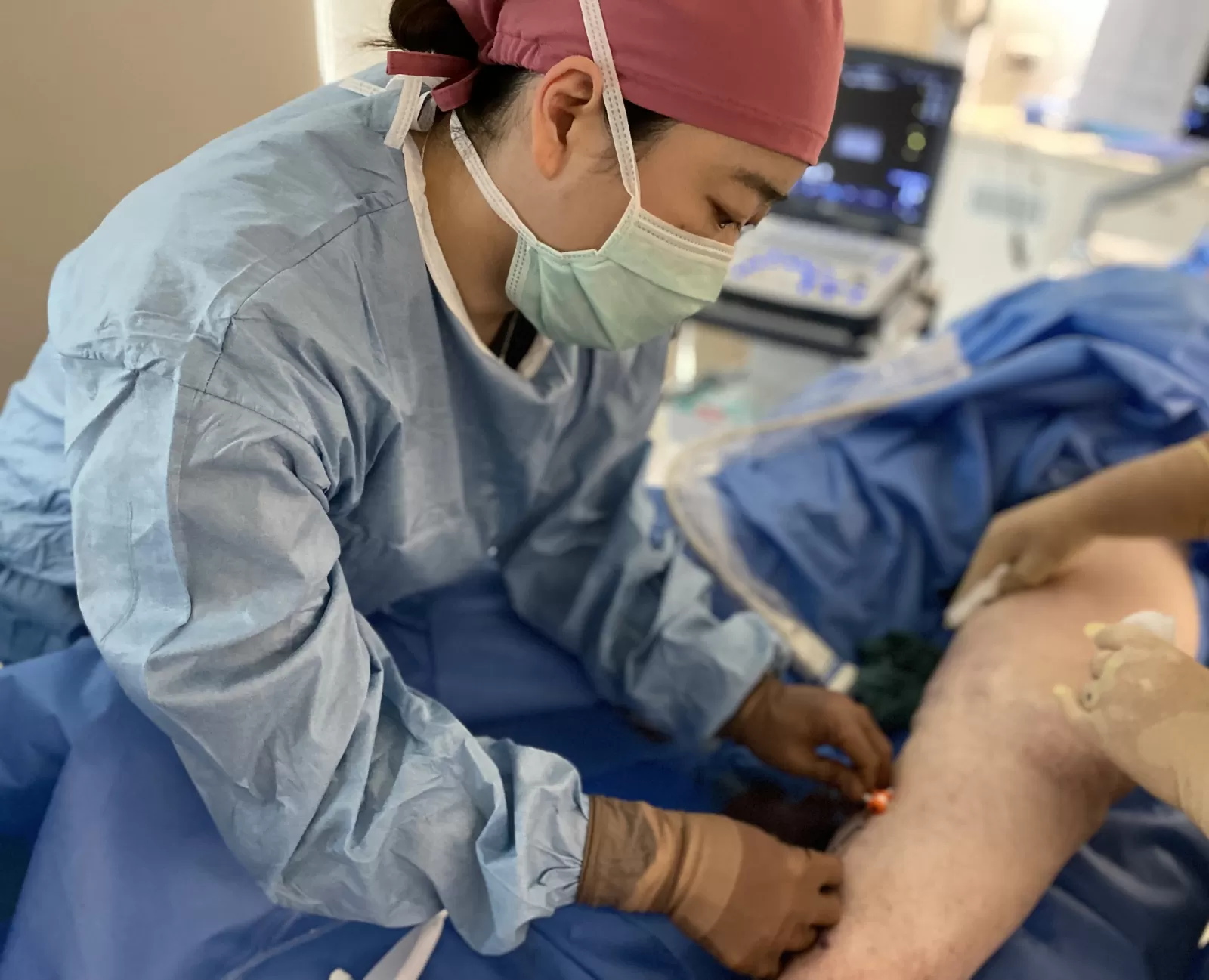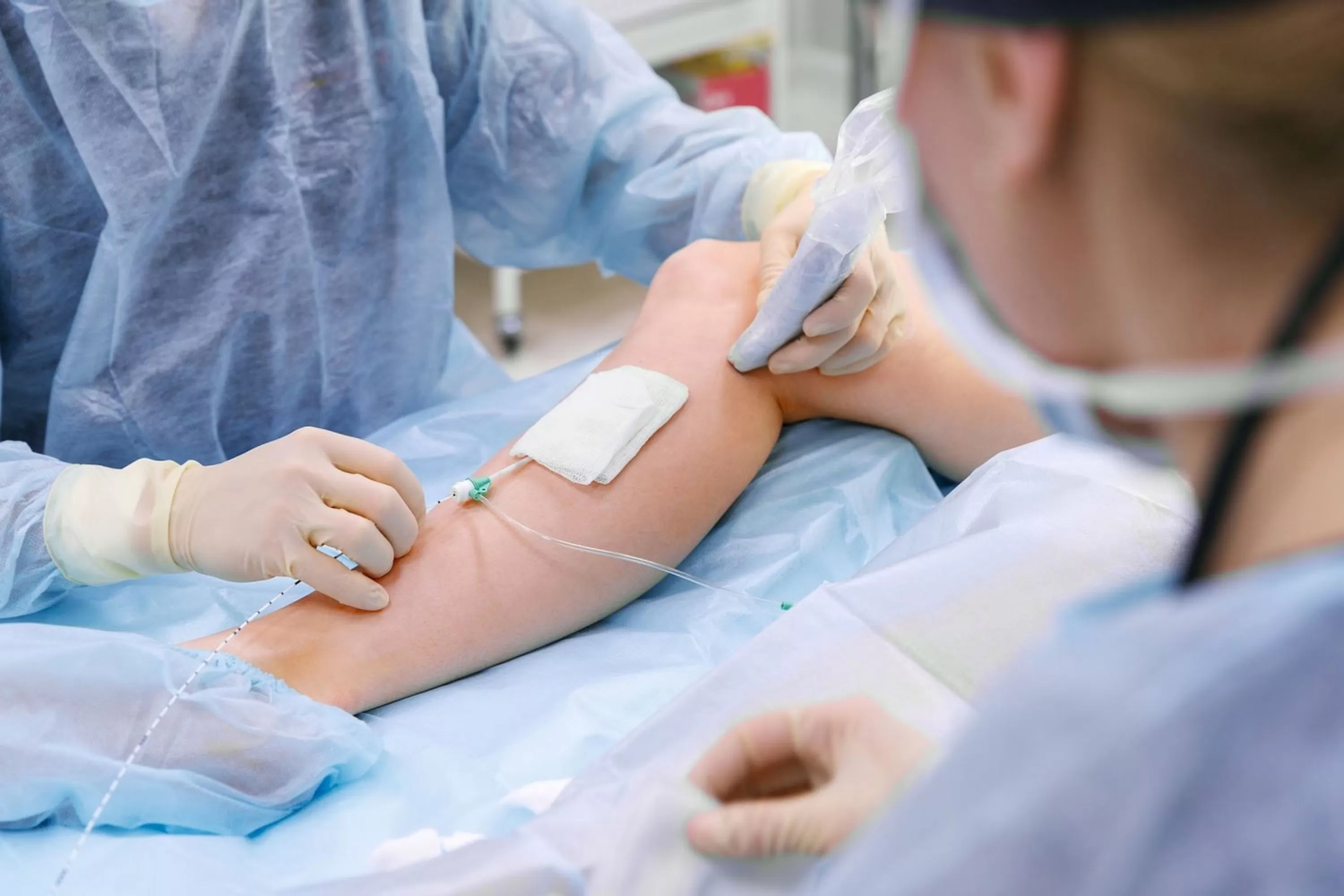Endovenous Thermal Ablation
Endovenous Thermal Ablation
Treatment
The R Clinics, Dr Melanie Sung is Australia’s first doctor to introduce the newly approved VENCLOSE® RF Ablation System for the treatment of diseased varicose veins.
Overview
Overview
Endovenous thermal ablation including, laser and radiofrequency ablation (two different techniques but with the same goal) is today one of the most popular, reliable, and effective vein treatment procedures and is commonly used alongside sclerotherapy for varicose vein treatment. At The R Clinic, endovenous thermal ablation is a walk-in and walk-out procedure performed under ultrasound guidance and tumescent anaesthesia. This means no hospital admission, general anaesthetic or hospital stay so patients can resume their lives and normal activities immediately after treatment.
How it works
How it works
Endovenous thermal ablation is a minimally invasive procedure in which thermal energy is used to block and collapse the diseased vein. During the procedure, a fine catheter is inserted into the vein via a small skin puncture and it is then fed into the diseased vein under ultrasound guidance. Around the length of the vein, your vein specialist will inject a tumescent solution, providing local analgesia, and protecting the tissues around the vein from any heat damage.
Once the tip of catheter is in position, your doctor will activate the device delivering thermal energy that (1) causes damage to the inner lining of the vein leading to shrinkage and collapse of the vein – radiofrequency ablation or (2) causes the blood in the vessel to clot, thereby sealing the vein and halting blood flow – laser ablation. Over time the treated varicose veins will gradually reabsorbed by the body and blood is re-routed to other healthy veins.
After the larger internal varicose veins have been treated, the other smaller varicose veins can then be addressed, typically with Ultrasound Guided Sclerotherapy.
Why we use Endovenous Thermal Ablation?
Why we use Endovenous Thermal Ablation?
- Endovenous thermal ablation (including both endovenous laser ablation & radiofrequency ablation) is considered the gold standard of varicose vein treatment over the past decade.
- It is a very well tolerated procedure with high success rate and far superior to those achieved by surgery
- It is a “walk-in & walk-out” procedure and can be done in outpatient setting
- Patient often experiences minimal discomfort and has very short recovery time compared to surgery
- Endovenous thermal ablation provides rapid symptom relief with minimal trauma. Many patients experience symptom relief and improved quality of life after their first treatment.
Expected Results
Expected Results
Some patients feel a tight, pulling sensation which they describe as a cord-like sensation. This can develop 1-4 weeks after treatment and resolves over time. It is common that patients may also experience slight discomfort and bruising along the course of the treated vein. If bruising occurs, it should improve in 1 to 2 weeks.
The varicose veins will take some time to fully disappear, depending on the severity of the disease and how long you have left them untreated. It is possible to eliminate varicose veins, but complete clearance is unlikely for spider veins. Treatment should restore an even and uniform appearance to the leg. An improvement of up to 80% can be expected within 6 months. Some patients may require additional treatment to further improve results.
- Treatment Time – 60/90 Minutes
- Discomfort – Mild
- Recovery – No downtime
- Compression – 14 Days
Preparation & Aftercare
Preparation
Preparation
- Prior to your treatment, you will first see our sonographer who will carefully mark out the areas to be treated using ultrasound, and you will also see our nurse who will take measurement of your legs to determine the size of your medical grade compression stocking
- Avoid taking iron supplement or blood thinner two weeks before your treatment
- Shower and remove any hair on the operative leg from ankle to around 3 finger widths into pubic hair the night before
- Bring your prescribed thigh high compression stocking to be put on after the procedure. If we order one for you, it will be here ready to be given to wear afterwards
During procedure
During procedure
- Your doctor will numb the area where the catheter will enter with local anaesthetic
- Ultrasound will be used to reveal the problem vein and its path.
- A catheter will be inserted into the vein through a tiny incision and carefully advance to the problem veins using ultrasound guidance
- Thermal energy will be released to heat the vein and seal it shut, as the catheter is slowly removed
- The incision will be covered with a bandage and medical grade compression stocking will be applied (no suture or stitches needed)
- The procedure usually takes approximately 60 minutes
Aftercare
Aftercare
- We ask all patients to go for a 30-minute walk immediately after the procedure – please stay around the clinic so you are close by if you need to return to see us for any reason.
- Wear compression stocking 24 hours a day for 7 days. This step is extremely important. Your compression stocking will help reduce bruises, swelling, pain and reduce DVT.
- Dressings – Any tape, gauze, dressings can be removed the next day
- Ideally do not take off the stocking while showering. To shower cover your stocking with a plastic cover. These can be purchased from your local chemist, if we provided stockings for you these will be included.
- Your stocking should be worn to bed. If, however, you experience pain in the foot or heel at night, especially if this pain wakes you up, you MUST remove the stocking while laying down in bed and put it back on again in the morning BEFORE you get up
- Work – you can return to work as soon as you feel able to do so
You will also need to walk a minimum of 30 minutes each day for 2 weeks after treatment - Two weeks after your treatment you will return for a follow-up ultrasound scan so that we can remove your compression stocking, see how your recovery is progressing, and exclude the very small risk of deep vein thrombosis

Results
FAQ
Have further questions or want to learn more?
Is the procedure painful?
There may be some minor discomfort with the administration of the local anaesthetic. However, most patients report little or no pain during the thermal ablation procedure once the anaesthetic takes effect.
What can I expect following the procedure?
Like any procedure it is expected to have some symptoms associated with the treatment. Patients can expect mild post treatment side effects and discomfort such as:
- Redness and bruising are common and often transient.
- Most skin discoloration can be transient, and most will resolve in three months. Rare cases, the darkening of the skin may persist for longer e.g., up to a year.
- Skin may be tender to touch. Gentle walking and wearing prescribed compression stocking will help lessen the discomfort.
- You may notice tender hard lumps under the skin. This is trapped blood and can be released at your follow-up appointment around 2 weeks post treatment.
- Aching legs. This can occur in the first few days after treatment. It is more common when larger veins are treated and is usually relieved by walking. You can take pain relief if needed.
- May experience a “pulling” or “tight” or “pulled muscle” sensation. This is the effect of the treated area healing. This will gradually improve over the next two weeks.
What is the estimated number of treatments I need?
The number of treatments varies from person to person and is determined by the condition of your veins.
When advising your treatment plan, the estimated number of treatments will be given to you in writing along with the estimated cost, this enables you to decide on whether to proceed with treatment and discuss further with our vein doctor.
What should I not do after vein ablation?
Avoid strenuous activities, such as bicycle riding, jogging, weightlifting, or aerobic exercise, until your vein doctor says it is okay. Avoid standing in place for long periods of time. Most people can return to work and normal activities right away.
Why is an ultrasound scan important prior to vein treatment?
Ultrasound provides an essential “road map” for our vein doctor to understand the exact nature of your vein dysfunction and plan the most appropriate treatment. Often what is seen on the surface is figuratively speaking the “tip of the iceberg”.
We have seen many patients have unsatisfactory outcomes when treated elsewhere without an investigative ultrasound first. Surface sclerotherapy performed without first eliminating venous reflux and “feeder vessels” for example may lead to new vessel growth and sometimes dramatic worsening in appearances.
Will the treated veins come back?
Treated correctly, no, those veins should not come back.
New veins may develop over time but whether this happens at all and how quickly depends on individuals’ genetics, how much standing or sitting you do each day and other factors such as starting the contraceptive pills, become pregnant or obesity. This is the reason we offer ongoing surveillance service to monitor for this. The sooner we can pick this up the sooner we can help you to address this.
How will treatment interfere with my work or usual routine?
The main effect on your daily routine is that you are required to wear a special compression stocking for a minimum one week (preferably two weeks) on your treated leg. This is important especially after any sclerotherapy or endovascular ablation. It is also important to walk regularly as part of your routine after treatment.
You should however avoid strenuous and intense physical exercise and avoid lifting of heavy objects for 4 days after treatment. Depending on your occupation, if your work duties involve lifting you may need to reduce some of these tasks for 4-5 days while you recover from your treatment.
You should also avoid long distance travel (trips longer than 4 hours) for 4 weeks after treatment. This is to minimise the risk of developing deep vein thrombosis (DVT).
How will my doctor decide upon my treatment pathway?
At your first appointment, our vein doctor will carefully assess your medical history and do a thorough physical examination. This is usually followed by a comprehensive venous duplex ultrasound to map out the causes of the problem
We will then explain the findings and discuss treatment options with you. There is plenty of time for questions. You will get detailed written information to take away and read through again at your convenience.
Can I have treatment during pregnancy or breast feeding?
No, we cannot perform treatment on veins if you are pregnant or breastfeeding as the effects on the developing baby or in breast milk are not known.
It is true that if you already have varicose veins, pregnancy is likely to make them worse. However, experts agree that treatment is best performed before or between pregnancies. Veins can be managed by wearing compression stockings. It may be inconvenient, but it is strongly advised.
